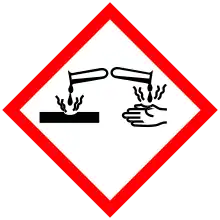2-tert-Butyl-1,1,3,3-tetramethylguanidine
2-tert-Butyl-1,1,3,3-tetramethylguanidine is an organic base, also known as Barton's base. It is named after Nobel Prize-winning British chemist Derek Barton. Barton and his assistants prepared a series of guanidines with steric hindrance in 1982; in this case five alkyl groups: four methyl groups and one tert-butyl group.[1][2] These bases were some of the strongest known at the time. In 50% water/ethanol, the acidity constant (pKa) of Barton's base is 14.[1] In acetonitrile its pKa is 24.31.
 | |
| Names | |
|---|---|
| IUPAC name
2-tert-butyl-1,1,3,3,-tetramethylguanidine | |
| Other names
BTMG, Barton's base | |
| Identifiers | |
3D model (JSmol) |
|
| ChemSpider | |
| ECHA InfoCard | 100.157.697 |
PubChem CID |
|
CompTox Dashboard (EPA) |
|
| |
| |
| Properties | |
| C9H21N3 | |
| Molar mass | 171.288 g·mol−1 |
| Hazards | |
| GHS pictograms |   |
| GHS Signal word | Danger |
| H302, H314 | |
| P260, P264, P270, P280, P301+312, P301+330+331, P303+361+353, P304+340, P305+351+338, P310, P321, P330, P363, P405, P501 | |
Except where otherwise noted, data are given for materials in their standard state (at 25 °C [77 °F], 100 kPa). | |
| Infobox references | |
Synthesis
The base is prepared by the reaction of tert-butylamine with a Vilsmeier salt. The latter is the reaction product of phosgene with N,N,N′,N′-tetramethylurea.
Applications
Barton's base can be used in many organic reactions, including in alkylations and in the formation of aziridines. It is often a milder alternative to traditional, strong inorganic bases.
References
- Barton, Derek H. R.; Elliott, John D.; Géro, Stephen D. (1982). "Synthesis and properties of a series of sterically hindered guanidine bases". J. Chem. Soc., Perkin Trans. 1 (0): 2085–2090. doi:10.1039/P19820002085.
- Reason and imagination : reflections on research in organic chemistry : selected papers of Derek H.R. Barton. World Scientific/Imperial College Press. ISBN 9810213611.
